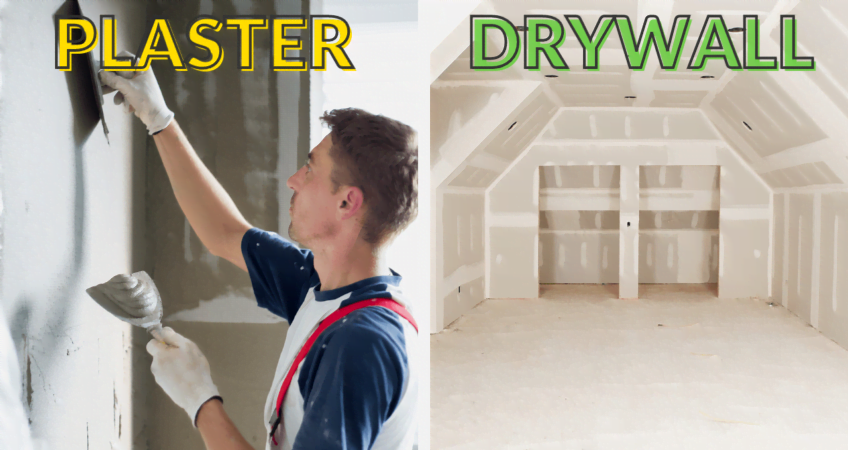Drywall vs Plaster: Gypsum is used in the manufacture of drywall because it does not crack. As part of the process of finishing the inside of a house, sheets of it are attached to the wooden studs using nails. Plaster, on the other hand, dries to a considerably more rigid state than drywall does, and it requires more labor and costs more money. The main difference between drywall and plaster is their composition. Drywall uses gypsum board while plaster uses cement and lime or gypsum.
Drywall is considered to be better than plaster. Following are some reasons why it is preferred over traditional plastering techniques:
- Drywall is cheaper
- Faster to Install
- Lighter weight
- Easy to repair
- Can be installed in any room
What’s in drywall?
Drywall is typically sold in enormous sheets of compressed gypsum that are wrapped in paper. Directly attaching it to the studs can be done by nailing or screwing it, however screwing is advised by the experts. Furthermore, a joint compound needs to be applied to the seams in order to make a continuous surface. A joint compound is a plaster-like compound and is more commonly referred to as mud. In comparison to plastering a wall, this method requires far less material and significantly less time to complete.
What is Plaster?
Plaster can be made from a variety of ingredients, the most common of which are gypsum, lime, or cement mixed with water and sand.
In the traditional method of laying a plaster wall, the framing studs must first be covered with wood lath. Wood lath consists of thin strips of wood that are attached horizontally to the studs. A base coat of plaster is applied by the worker to cover the gaps, further layers of plaster are applied.
Is it better to plaster or drywall?
Drywall vs Plaster: Plaster is, by its very nature, a more enduring surface than drywall, even higher-level drywall treatments. This is true regardless of the quality of the drywall finish. Plaster surpasses drywall in a number of important categories, including insulation, soundproofing, and fireproofing. It is also more cost-effective than drywall. Plaster has another advantage over other building materials in that it does not support the growth of mold due to its inherent composition.
Moreover, Plaster is more fragile and difficult to work with than drywall. When the wall is made of drywall, it is feasible to use binder clips to hang posters on the wall. However, when the wall is made of plaster, it is quite unlikely that the point of a clip could penetrate the plaster. Most significantly, there is a possibility that the plaster will chip or crack as a result of your actions.
Which one is cheaper? Drywall or plaster?
Drywall is cheaper than drywall when it comes to the cost of installation, despite the fact that the material costs of plasterboard and drywall are generally the same. Plaster is also more difficult to work with. The fact that applying plaster requires more specialist work than laying drywall is something that has already been brought up.
Can you replace plaster with drywall?
Drywall vs Plaster: It is possible to cover lath (a thin flat strip of wood), and plaster walls with drywall or to replace them entirely in order to bring them up to date. By placing drywall sheets on top of the old plaster, you can hide its appearance. This is the easiest and cleanest method to do the task at hand, but it is not usually the most productive.
What are the advantages of plaster?
- Durability: Plaster was created to survive for ages, making it significantly more strong than the more recent material known as drywall in terms of artistry.
- Artistry: Drywall is nothing more than a flat surface that is used to cover a wall frame
- Acoustics.
- Versatility.
- Cleanliness and Speed of Installation. …
- No Job Is Too Small.
What are the disadvantages of using plaster?
Disadvantage: Installation
It takes several days to finish the drywall to a smooth surface since the joint compound that seals the joints between panels needs to dry before another coat can be applied. Plaster does not generate any dust on its own, with the exception of a trace quantity that is produced.
How much more expensive is plaster than drywall?
Drywall Cost. Installing drywall costs between $1 and $3 per square foot while plastering costs anywhere from $2 to $10 per square foot. Plastering is often more expensive because it takes more time than hanging drywall and requires more expertise.
Plastering is typically more expensive than hanging drywall because it takes significantly more time and requires significantly more expertise. It can range in price anywhere from $2 to $10 per square foot, but installing drywall can cost anywhere from $1 to $3 per square foot.
Are plaster walls hard to clean?
Plaster is a dense material; therefore, you do not want to get it too moist, or else you will soon be in need of the services of an expert in plaster repair. When you consider that the plaster could have lasted for decades, this may be an issue. If you want to clean your plaster without causing any damage to it: Soak a gentle cloth in warm water, and then squeeze it.
What kind of walls do old houses have?
Plaster is typically used in older homes as well as in high-end modern construction. It is harder and more durable than other building materials, but it also has a higher installation cost. Plaster is typically put in three coats using a technique that is applied over wood or metal lath in older homes.
In newly constructed homes, a single layer is often put over the blue board, which is a specialized kind of drywall.


